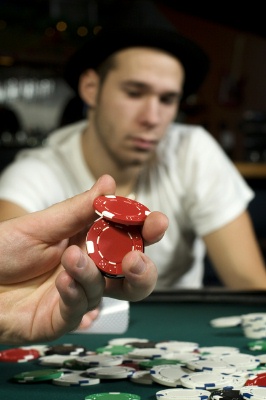|
|

Loose - A style of play in which a player plays a high percentage of hands, frequently calls bets or raises, and often
initiates betting or raising.
Poker play can be described as being somewhere on a spectrum which runs from loose to tight. Players typically adopt a style of play
that skews toward one end of the spectrum or the other. Loose play is characterized by a lot of betting and calling, and includes an
inclination to play a high percentage of hands and call a high percentage of wagers. Tight play, on the other hand, is characterized
by a lot of conservative and risk adverse play, and includes an inclination to muck, when the question of who has the best hand seems
to be in doubt.
Poker play can also be described as being on another spectrum which runs from passive to aggressive. Passive play includes an
inclination to check rather than bet, to call rather than raise, and to bluff infrequently, if at all. Aggressive play is just the
opposite. It includes an inclination to bet rather than check, to raise rather than call, and to bluff and semi-bluff with regularity.
These two spectra, the loose-tight spectrum and the passive aggressive spectrum, are complementary. By this I mean that they are both
used together, synergistically, to bring a heightened understanding of the nature of someone’s play. So a person’s play could be
characterized as loose-passive (LP), loose-aggressive (LAG) tight-passive (TP), or tight-aggressive (TAG). These are basically the
four different ways to approach the game, and your style of play is defined by which strategy you choose.
You should know that all playing styles are not created equal, and that the style that you adopt will have a dramatic impact on your
results. You should also realize that style should not be static. You will need to adjust your play, and that means adjusting your
positioning on both spectra, based upon the style of your opponents play. The first point that I want to make, is that most
professionals and many of the world’s top players have all adopted strategies which may vary some, but can generally be defined as
tight-aggressive. There are also a few successful players who can be described as loose-aggressive, especially by those on the tighter
end of the spectrum. Very few, if any, passive players have long term success with their playing styles. There may be a few
tight-passive grinders who can squeeze out a few pennies, but virtually all of them would fare better if they would get more
aggressive in the right spots. The bottom line is that aggression wins, and tight aggressive play frequently dominates.
It is a sign of excellent play, to be able to make appropriate adjustments to your playing style, based upon the play of your
opponents. If you sense that players are playing too tight, you should adjust your play by raising more and
stealing more. If you sense that they are being too
aggressive, you set more traps for them, and so on. Frequently, but not always, it makes sense to adjust in the opposite direction of the
spectrum from where your opponents are coming from. The one thing that you want to be careful about is that you do not try to counter
extreme aggression with extreme passivity. There are times when you can make extra bets by checking and letting your opponent bluff off
his stack. You should make this play from time to time, but don’t let it become your style of play. If you do, you become a calling station,
which is not a successful playing style to adopt. It is better to counter extreme aggression with targeted aggression. When someone is
speeding, you set big traps, and you pound them when you know you have the best of it. You respond to their aggression with an equal measure
of your own, but you do it less recklessly than they do. Remember, the line between good, aggressive play and speeding can be pretty thin at
times. If you loosen up your game too much, or if you become too aggressive with the wrong hands, it can destroy your bottom line, because
you will end up getting in too much money with the worst of it. Speeders rarely have long term success. Neither do nits. If you want to have
success over the long run, you should adopt a style somewhere in between (that is suitable for you) and you should be prepared to make
adjustments to it when it is appropriate to do so.
Usage: Loose Cannon, Play Looser, Loosen Up Your Play, Loose Call
See also LAG - Loose Aggressive Playing Style
Previous Poker Term: Lock
Next Poker Term: Lowball
|
|









